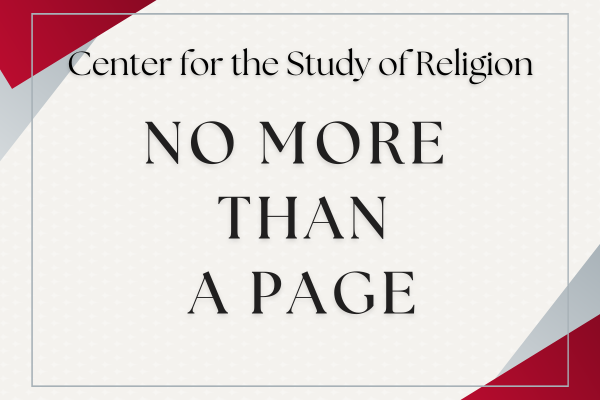
Please join us for the next installment in our "No More Than A Page" series. This series gives an opportunity for faculty and advanced graduate students to receive feedback on their research in process. Presenters provide attendees with a one-page summary of their current research and attendees engage in a lively discussion.
This installment will feature Patrick Dunn, Ph.D Student & Graduate Teaching Associate in the Department of Comparative Studies. Patrick was the recipient of last year's Iles Award for the Study of Myth from the Center for the Study of Religion.
Since the 1950s, the modern UFO phenomenon has been animated by creative syntheses of spiritual practice with technoscientific applications. Some regard the "nonhuman intelligence" of UFOs themselves as at once a manifestation of "consciousness-assisted technology" and "technology-assisted consciousness." Here I discuss specific living communities inspired by "CE-5" contact modalities - their methods and what those suggest about the place of UFO contact within the history of religions.
Patrick's current research focuses on the modern UFO/UAP phenomenon and its relationship to historical formations of religion and spirituality. His dissertation traces a logic of secrecy and initiation that connects ancient mystery schools, early modern secret societies, and contemporary technoscientific, military, and intelligence operations. By showing how the UFO phenomenon implicates technology and spirituality, science and myth, materiality and consciousness, this genealogy calls for a rethinking of the nature of religion and its role in shaping the modern world.
This event is free and open to the public. Co-hosted by the Center for the Study of Religion, the Department of Comparative Studies and the Humanities Institute.
Patrick's Page of Research
In 2025, Australian journalist Ross Coulthart, reporting for NewsNation, released a two-hour video interview with Jacob Barber. Barber is a former U.S. Air Force officer, helicopter pilot, and intelligence operative, who claims to have participated in many sensitive missions. In the interview Barber describes being part of a covert team tasked with recovering exotic technologies, including aerial systems, some of which he came to regard as being of “nonhuman origin.”
Barber recounts his team’s use of “psionic assets,” individuals with exceptional psychic abilities, in some instances recruited or abducted from indigenous communities and other targeted populations around the world. These individuals were trained to initiate remote psychic contact with nonhuman craft, guiding them into a position where they could be compelled to land (sometimes through the use of high-powered microwave weapons). The craft would then be retrieved and taken to a secure location for further analysis.
The operations described by Barber are not new or unique but reflect motifs that have long been present in UFO contact narratives. Barber’s team inhabits the shadowy world of “UFO craft retrievals,” where classified technologies and scientific research intersect with covert military and intelligence operations and state-protected corporate agendas. The practices, orientations, and encounters involved in these missions, however, belong to a much broader pattern, found not only in modern UFO subcultures, but throughout the history of shamanic initiation, magical conjuring, religious ritual, and spiritual transformation.
In some modern UFO contexts, these dynamics have been formalized into teachable, repeatable protocols – such as Steven Greer’s CE-5 (Close Encounters of the Fifth Kind) and Joseph Burke’s HICE (Human-Initiated Contact Experience). In other cases, the methods of UFO contact are looser and more spontaneous. Collectively, such protocols and methods have come to be known among UFO researchers as “contact modalities.”
Modern practitioners engaged with contact modalities often combine emergent sensor and communication technologies – such as night vision, laser, and electromagnetic pulse – with regimes of practice rooted in traditional spiritual discipline – such as meditation, mantra, visualization, and yogic breathing. Such practitioners commonly theorize UFO contact as taking place through a fluid, only inchoately understood, interface between technology and consciousness. Yet, “consciousness” here designates a medium already thoroughly pervaded by technological complexity.
My suggestion is that this technologization – both of UFO contact and of consciousness – reflects the breakdown of traditional onto-political orderings and the emergence of distinctively modern strategies of secrecy and initiation. In this way, modern UFO contact both extends ancient formations of esoteric and occult religiosity and transmutes their powers into technoscientific, often militarized forms.
The Humanities Institute and its related centers host a wide range of events, from intense discussions of works in progress to cutting-edge presentations from world-known scholars, artists, activists and everything in between.
We value in-person engagement at our events as we strive to amplify the energy in the room. To submit an accommodation request, please send your request to Cody Childs, childs.97@osu.edu
